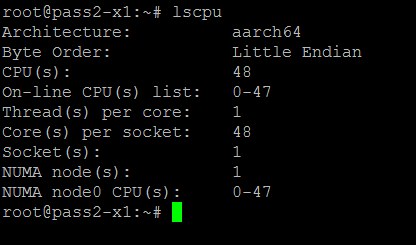Investigating Cavium's ThunderX: The First ARM Server SoC With Ambition
by Johan De Gelas on June 15, 2016 8:00 AM EST- Posted in
- SoCs
- IT Computing
- Enterprise
- Enterprise CPUs
- Microserver
- Cavium
ThunderX SKUs: What is Cavium Offering Today?
Cavium has been promising SKUs with 16 cores or 48 cores, with clockspeed ranges between 1.8 GHz and 2.5 GHz, with a TDP of up to 95W. While I am typing this article, Cavium has not published a full spec list of the different SKUs and the real silicon is different from the paper specs. So we will simply jot down what we do know.
The SKU we tested was the ThunderX-CP CN88xx 2 GHz. It is hard to identify the CPU as the usual Linux CPU identification tools do not tell us anything. Only the BIOS can gave some info:
The SKU we tested (CN8890), has 48 cores at 2 GHz, inside a TDP of 120W and costs around $800. This is the SKU that is being produced at mass scale.
What we know so far:
- SKUs available with Clockspeeds of 1.6 GHz and 1.8 GHz with lower TDPs than 120W (2 GHz)
- Highest clock is 2 GHz
- SKUs with 24, 32, and 48 cores
- Available in all families (Cloud, Storage, Security, Networking) and currently in productions
TDP ranges from 65W (low end, 24 cores at 1.8 GHz ?) to 135W (probably a 48-core SKU at 2 GHz with most features turned on).
But it is safe to say that Cavium missed the target of 48-cores at 2.5 GHz inside a 95W power envelope. That probably was too optimistic, given the fact that the chip is baked with a relatively old 28 nm high-k metal-gate process at GlobalFoundries.












82 Comments
View All Comments
JohanAnandtech - Wednesday, June 15, 2016 - link
Good suggestion. I have been using an ipmi client to manage several other servers, like the IBM servers. However, such a GUI client is still a bit more userfriendly, ipmi commands can get complicated if you don't use them regularly. The thing is that HP and Intel's BMC GUI are a lot easier to use and more reliable.fanofanand - Wednesday, June 15, 2016 - link
I think you may have an inaccurate figure of 141 at idle (in the graph) for the Thunder. "makes us suspect that the chip is consuming between 40 and 50W at idle, as measured at the wall"JohanAnandtech - Wednesday, June 15, 2016 - link
If you look at the Column "peak vs idle", you see 82W. At peak, we assume that a 120W TDP chip will probably need about 130W. 130W - 82W (both measured at the wall) = 50W for the SoC alone at idle measured at the wall, so anywhere between 40-50W in reality. My Calculation is a "guestimate", but it is clear that the Cavium chip needs much more in idle than the Intel chips.(10-15W) .djayjp - Wednesday, June 15, 2016 - link
Many spelling/grammar issues here. It impacts readability. Please read before posting.djayjp - Wednesday, June 15, 2016 - link
That is to say in the article.mariush - Wednesday, June 15, 2016 - link
These guys are already working on ThunderX2 (54 cores, 3 Ghz , 14nm , ARMv8) and they already have functional chips : https://www.youtube.com/watch?v=ei9uVskwPNEMeteor2 - Thursday, June 16, 2016 - link
It's always jam tomorrow, isn't it? Intel is working on new chips too, you know.beginner99 - Wednesday, June 15, 2016 - link
It loses very clearly in performance/watt to Xeon-D. In this segment the lower price doesn't matter in that case and the fact that it has a process disadvantage doesn't matter either. What counts is the end result. And I doubt it would cost $800 if made on 14/16nm. I mean why would anyone buying this take the risk? Safer bet to go with Intel also due to more flexible use (single and multi threaded). The latency issue is mentioned but downplayed.blaktron - Wednesday, June 15, 2016 - link
So downplayed. Anandtech desperately wants ARM servers, but its a solution looking for a problem. Big web front ends running on bare metal are such a small percentage of the server market that developing for it seems stupid. Xeon-D was already in development for SANs, they just repurposed it for docker and nginx.Senti - Wednesday, June 15, 2016 - link
Very nice article. I especially liked the emphasis on relations of test numbers and real world workloads and what was problematic during the testing.It would be great to see the same style desktop CPU review (Zen?) form you instead of mix of reprinted marketing hype with silly benchmark numbers dump that plagues this site for quite some time now.
Some annoying typos here and there, like "It is clear that the ThunderX is a match for high frequency trading", but nothing really bad.